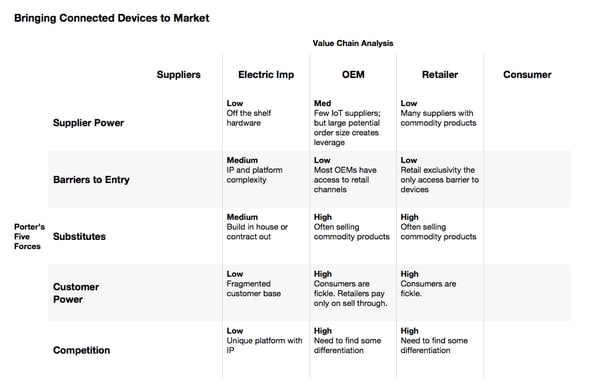When I first started in venture capital five years ago, I wanted to create a programmatic way to analyze companies well. My goal was to be able to step into a meeting with an entrepreneur with some kind of form that I would fill out throughout the meeting, so that by the end of the meeting I might have an understanding how the startup fits into its ecosystem.
It took quite a while to devise this framework and to revise it until it became useful, practical and insightful. I spoke with friends who were consultants and who analyze companies for a living. I read many books on the topics of competition and strategy. Last, I spoke with other investors.
But in the end I chose three simple frameworks that were already well-known and which fit together on two sheets of paper: The Business Model Canvas, Porter’s Five Forces, and Value Chain Analysis.
Each of these frameworks evaluates a different aspect of the business. The Business Model Canvas explains concisely how a business operates. Value Chain Analysis describes where the startup fits within an ecosystem and Porter’s Five Forces exposes the level of competition the startup will face.
I’m sharing these in the hopes that these frameworks might benefit entrepreneurs when selecting ideas to pursue, refining go-to-market strategy and pitching their businesses to investors.
The Business Model Canvas
The first sheet of paper is the Business Model Canvas which is a framework invented by Alexander Osterwalder in a great book called Business Model Generation.
The BMC describes the key operations of a business: the Value Proposition, the Key (Operating) Activities, Partners, Assets/Resources, Customer Relationships, Go-To-Market Channels, Customer Segments, Cost Structure and Revenue Streams.
Filling out this form creates a document that captures what a business offers, how it reaches which customers and how profitable it could be.
The Grand Unifying Framework - Matrixing Value Chains and P5F
To set the business in proper context is to understand the business environment around it. To do this, I’ve matrixed the Porter’s 5 Forces Analysis and Value Chain Analysis. Combining the two yields a chart like the one below which I’ve filled out for a company I work with called Electric Imp. Electric Imp provides the infrastructure to connect all kinds of devices to the web. We sell this technology to Original Equipment Manufacturers (OEMs). I call this chart the GUF (Grand Unifying Framework).
The horizontal categories denominate the value chain and the vertical categories are Porter’s Five Forces
Filling out this chart accomplishes three things. First, it enumerates the value chain. Second, it offers a lens into the motivations of each player within the ecosystem. Third, it provides visibility into which players in the ecosystem have the most power and control the dollars. Each of these three concepts is essential to understand when entering a market.
What To Look For In These Analyses
The GUF shows the player/column the ecosystem has the most power. The column that has lowest supplier power, lowest customer power, no substitutes and highest barrier to entry is the most powerful player in the ecosystem and the one that will dictate the way most other players do business.
Secondly, the GUF indicates how much competition exists within one part of the value chain in the competition row. Ideally, there isn’t much competition and the barriers to entry are high which will mean a higher margin business. Intense competition means an efficient market and low margins.
The BMC is a description of how a company goes to market. A well defined value proposition is the most critical thing. Next, understanding the customers and customer segments is also quite important. Last, the cost structure of the business is critical. This determines burn rate and capital requirements. For an early stage company, most of the other categories, including revenue model can be fuzzy. But the more detailed and fleshed out the BMC, the better.
Frameworks FTW
Frameworks provide a structured way of thinking about things and these three help me understand startups at a deeper level. I hope these frameworks help you choose the best idea to pursue, find the most effective path to market and help you to pitch your startup idea most effectively.
